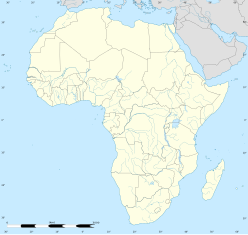Tenoumer crater
| Tenoumer crater | |
|---|---|
| Impact crater/structure | |
| Confidence | Confirmed |
| Diameter | 1.9 km (1.2 mi) |
| Depth |
|
| Age | 21,400 ± 9,700 |
| Location | |
| Coordinates | 22°55′5″N 10°24′27″W / 22.91806°N 10.40750°W |
| Country | Mauritania |
Tenoumer is considered to be an impact crater in Mauritania.[1]


Details
The crater is located in the western Sahara Desert. It is 1.9 km (1.2 mi) in diameter and the age is estimated to be 21,400 ± 9,700 years old, placing it in the Pleistocene epoch.[2][3]
The crater is exposed at the surface and is nearly circular. Edges of the crater rise up to 110 m (360 ft) high above the base of the crater, but the bottom of the crater is covered with approximately 200 to 300 m (660 to 980 ft) thick layer of sediments.[citation needed]
Tenoumer crater has formed in gneiss and granite of Precambrian peneplain with a thin layer of Pliocene sediments (no older). The crater is believed to be caused by an impact event due to basement rocks found outside the crater. A volcanic origin was once theorized] because of the discovery of basalt and rhyodacite outside of the crater basin,[4] but current evidence clearly indicates an impact origin.[5]
References
- ^ "Tenoumer". Earth Impact Database. Planetary and Space Science Centre University of New Brunswick Fredericton. Retrieved 2009-08-16.
- ^ Jaret, S. J.; Kah, L. C.; French, B. M. (2009). "Petrographic Investigation of Ejecta from the Tenoumer Impact Crater, Mauritania" (PDF). 40th Lunar and Planetary Science Conference. Lunar and Planetary Institute.
- ^ Storzer, D.; Selo, M.; Latouche, L.; Fabre, J. (2003). "The Age of Tenoumer Crater, Mauritania, Revisited" (PDF). Lunar and Planetary Science Conference. XXXIV. Lunar and Planetary Institute: 1183. Bibcode:2003LPI....34.1183S.
- ^ METEORITE OR VOLCANO?
- ^ Brügge, Norbert. "The "impact" craters of Mauritania: Aouelloul, Tenoumer, Temimichat and El Mrayer". Archived from the original on 2010-02-23.



